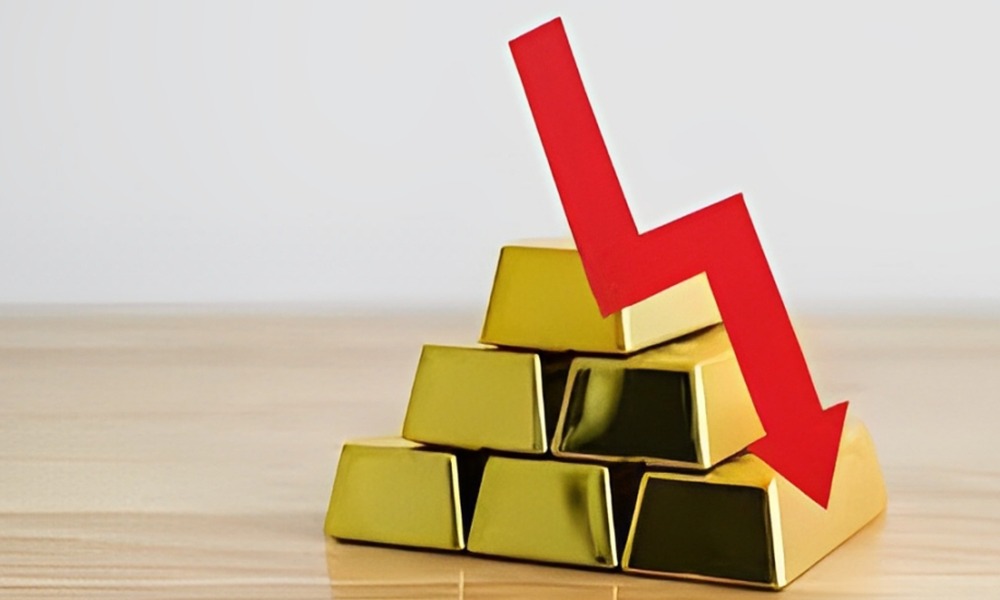International News
Gold declines and investors opt for dollar, prioritize liquidity

Gold, often considered the quintessential safe-haven asset, witnessed a notable retreat on Monday, slipping over 2% from last week’s record highs. This downturn came as investors, rattled by escalating trade tensions between the U.S. and China, shifted their focus towards the U.S. dollar and other safe-haven currencies like the Swiss Franc and Japanese Yen. The move reflects a broader market recalibration in the face of renewed economic and geopolitical uncertainties.
Spot gold prices fell by 2.4%, settling at $2,963.19 an ounce by early afternoon ET. During the session, the precious metal touched a near four-week low of $2,955.89. Meanwhile, U.S. gold futures also closed 2% lower at $2,973.60. This decline follows an all-time high of $3,167.57 reached just last Thursday, underscoring the volatility gripping the commodities market.
Investor sentiment shifted in favor of the U.S. dollar, which rebounded from a six-month low. A stronger dollar makes gold more expensive for holders of other currencies, putting downward pressure on its price. This change in preference indicates that, during times of acute uncertainty, investors may prioritize liquidity and ease of access — qualities traditionally associated with the dollar — over long-term value storage like gold.
The gold market is currently experiencing significant stress, largely driven by liquidity concerns and speculative activity. According to Bart Melek, head of commodity strategies at TD Securities, margin covering by traders — the need to cover losses on leveraged positions — has added to gold’s downward pressure. This phenomenon typically accelerates declines as investors sell assets to raise cash.
The primary catalyst for the market turmoil is the intensification of the U.S.-China trade conflict. President Donald Trump has floated the possibility of imposing a 50% tariff on Chinese imports if Beijing fails to roll back its own retaliatory tariffs. Meanwhile, speculation that the U.S. administration might pause tariffs for 90 days on all nations except China was dismissed by the White House as “fake news,” adding to the confusion and uncertainty.
Despite the short-term dip in gold, the broader macroeconomic backdrop continues to support a bullish outlook for the precious metal. Futures markets are now pricing in approximately 120 basis points of rate cuts from the U.S. Federal Reserve by the end of the year. The probability of a rate cut as early as May has also risen to 37%. Lower interest rates reduce the opportunity cost of holding non-yielding assets like gold, thereby boosting their attractiveness.
Analysts remain optimistic about gold’s long-term potential. The metal continues to benefit from robust central bank demand and remains a favored hedge during periods of financial instability and geopolitical strain. The recent correction may be seen more as a pause or consolidation phase rather than a reversal of trend, particularly given the fragile state of the global economy.
DiamondBuzz
Lesotho’s Largest Diamond Mine Faces Imminent Closure Without State Tax Relief
Government Refusal to Waive Taxes and Royalties Threatens 750 Jobs and 10% of National GDP Amid Diamond Price Collapse.

The Kao Diamond Mine, Lesotho’s largest diamond operation and a crucial contributor to the national economy, is facing imminent closure within weeks, according to operator Storm Mountain Diamonds (SMD). The company, which is 75% owned by Namakwa Diamonds Limited and 25% by the Government of Lesotho (GOL), has issued a dire warning, appealing for urgent financial relief to avoid shutdown.
The crisis is driven by a steep global decline in diamond prices and demand, coupled with a deepening dispute over tax and royalty obligations.
- Financial Strain: SMD’s revenue has plummeted, with 2024 sales hitting only $50 million from approximately 250,000 carats sold—less than half of its $105 million revenue in 2022.
- Urgent Need: The company requires approximately $13 million in new investment to maintain operations over the next year.
- Regulatory Deadlock: SMD claims the Lesotho Revenue Services (LRS) has breached binding original mining agreements by imposing higher tax rates, restricting deductions, and withholding VAT refunds. This lack of a stable regulatory environment is deterring potential investors.
- Sought Relief: SMD has formally requested the GOL to suspend tax assessments and waive royalty payments to secure the necessary investment and extend the mine’s lifespan.
Economic Fallout:
The potential closure poses a significant threat to Lesotho’s economy. The diamond mining sector accounts for around 10% of the country’s GDP and up to a quarter of its total exports by value. The shutdown would result in the loss of approximately 750 jobs and could severely undermine investor confidence in one of Southern Africa’s key mining industries.
The GOL faces a difficult decision: offering assistance to a company in which it is a direct shareholder while managing public perception and the demands of its tax authority. Industry analysts warn that a failure to reach an agreement swiftly could trigger a major economic and employment blow.
-

 National News2 hours ago
National News2 hours agoRBI accelerates repatriation of its gold reserves, 64 ton brought home last 6 months
-

 National News3 hours ago
National News3 hours agoGold price decline will stimulate shopping during November-March wedding season
-

 DiamondBuzz41 minutes ago
DiamondBuzz41 minutes agoLesotho’s Largest Diamond Mine Faces Imminent Closure Without State Tax Relief
-

 GlamBuzz2 hours ago
GlamBuzz2 hours agoJennifer Lopez Named Ambassador for Zen Diamond







